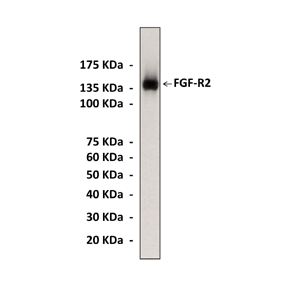Anti-FGF-R2: Polyclonal Fibroblast Growth Factor-Receptor 2 Antibody |
 |
Fibroblast growth factors (FGFs) have been implicated in numerous cellular processes, including proliferation, migration, differentiation, and survival. The 22 members of the fibroblast growth factor (FGF) family of growth factors mediate their cellular responses by binding to and activating the different isoforms encoded by the four receptor tyrosine kinases (RTKs) designated FGFR1, FGFR2, FGFR3 and FGFR4. Unlike other growth factors, FGFs act in concert with heparin or heparan sulfate proteoglycan (HSPG) to activate FGFRs and to induce the pleiotropic responses that lead to the variety of cellular responses induced by this large family of growth factors.1 Whereas FGF-2 (bFGF), the prototypic ligand in a family of 22 members, activates all four tyrosine kinase FGF receptors (FGFR1-FGFR4), other members demonstrate a higher degree of selectivity.2 The amino-acid sequences of four FGF receptors have related features. The cytoplasmic region is principally composed of the tyrosine kinase domain, and it contains a number of consensus tyrosine residues that could act as phosphate acceptors for autophosphorylation. Most, but not all, of these residues are conserved amongst the FGF receptor family. The receptor extracellular region comprises three domains, IgI–IgIII, each of which exhibits clear hallmarks of the immunoglobulin superfamily of structural modules.3 The binding of FGF and HSPG to the extracellular ligand domain of FGFR induces receptor dimerization, activation and autophosphorylation of multiple tyrosine residues in the cytoplasmic domain of the receptor molecule.4 A variety of signaling proteins are phosphorylated in response to FGF stimulation including Shc, phospholipase-Cγ, STAT1, Gab1 and FRS2α leading to stimulation of intracellular signaling pathways that control cell proliferation, cell differentiation, cell migration, cell survival and cell shape. The docking proteins FRS2α and FRS2β are major mediators of the Ras/MAPK and PI-3 kinase/Akt signaling pathways as well as negative feedback mechanisms that fine-tune the signal that is initiated at the cell surface following FGFR stimulation.
A variety of human skeletal dysplasias have been linked to specific point mutations in FGFR1, FGFR2 and FGFR3 leading to severe impairment in cranial, digital and skeletal development. Gain of function mutations in FGFRs were also identified in a variety of human cancers such as myeloproliferative syndromes, lymphomas, prostate and breast cancers as well as other malignant diseases.4
REFERENCES
1. Dailey, L. et al: Cytokine Growth Factor Rev. 16:233, 2005.
2. Fortin, D. et al: J Neurosci. 25:7470, 2005.
3. Wilkie, A.O.M. et al: Curr. Biol. 5:500, 1995.
4. Eswarakumar, V. P. et al: Cytokine Growth Factor Rev. 16:139, 2005.
2. Fortin, D. et al: J Neurosci. 25:7470, 2005.
3. Wilkie, A.O.M. et al: Curr. Biol. 5:500, 1995.
4. Eswarakumar, V. P. et al: Cytokine Growth Factor Rev. 16:139, 2005.
Products are for research use only. They are not intended for human, animal, or diagnostic applications.
Параметры
|
Cat.No.:
|
CB4365
|
|
Antigen:
|
E. coli-expressed recombinant human FGFR-2 cytoplasmic protein fragments.
|
|
Isotype:
|
Rabbit IgG
|
|
Species & predicted
species cross-
reactivity ( ):
|
Human, Mouse, Rat
|
|
Applications &
Suggested starting
dilutions:*
|
WB 1:1000
IP n/d
IHC n/d
ICC n/d
FACS n/d
|
|
Predicted Molecular
Weight of protein:
|
145 kDa
|
|
Specificity/Sensitivity:
|
Detects endogenous levels of FGFR-2 proteins. Does not cross-react with other FGFR family members.
|
|
Storage:
|
Store at -20°C, 4°C for frequent use. Avoid repeated freeze-thaw cycles.
|
*Optimal working dilutions must be determined by end user.
Информация представлена исключительно в ознакомительных целях и ни при каких условиях не является публичной офертой








